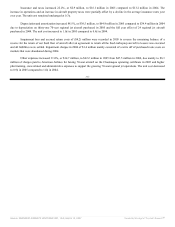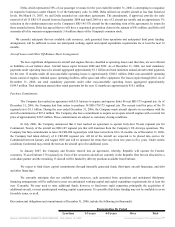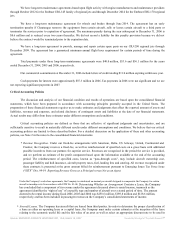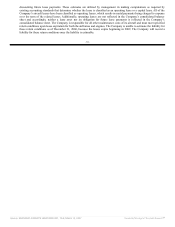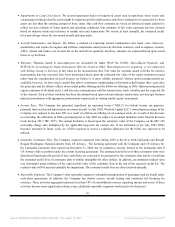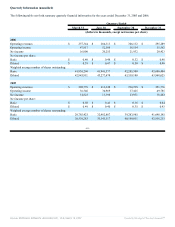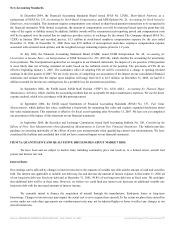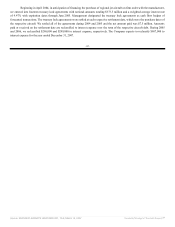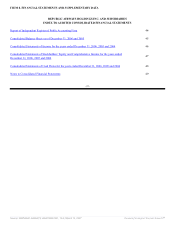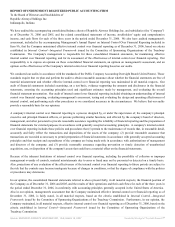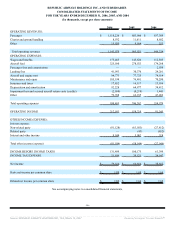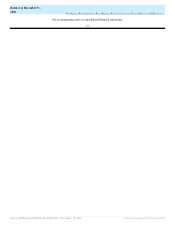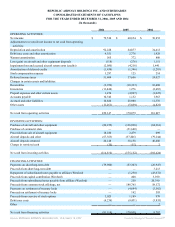Frontier Airlines 2006 Annual Report Download - page 74
Download and view the complete annual report
Please find page 74 of the 2006 Frontier Airlines annual report below. You can navigate through the pages in the report by either clicking on the pages listed below, or by using the keyword search tool below to find specific information within the annual report.
New Accounting Standards
In December 2004, the Financial Accounting Standards Board issued SFAS No. 123(R), Share-Based Payment, as a
replacement of SFAS No. 123, Accounting for Stock-Based Compensation, and APB Opinion No. 25, Accounting for Stock Issued to
Employees, was rescinded. This statement requires compensation costs related to share-based payment transactions to be recognized in
the financial statements. With limited exceptions, the amount of compensation cost will be measured based upon the grant date fair
value of the equity or liability issued. In addition, liability awards will be remeasured each reporting period and compensation costs
will be recognized over the period that an employee provides service in exchange for the award. The Company adopted SFAS No.
123(R) in January 2006 and recorded, pre-tax, $1.3 million in stock-based employee compensation expense for the year ended
December 31, 2006. At December 31, 2006 there was $2.0 million of unrecognized stock-base employee compensation expense
associated with unvested stock options, and the weighted average remaining expense period is 1.2 years.
In July 2006, the Financial Accounting Standards Board (FASB) issued FASB Interpretation No. 48, Accounting for
Uncertainty in Income Taxes—an Interpretation of FASB Statement No. 109 (FIN 48), which clarifies the accounting for uncertainty
in tax positions. This Interpretation requires that we recognize in our financial statements, the impact of a tax position, if that position
is more likely than not of being sustained on audit, based on the technical merits of the position. The provisions of FIN 48 are
effective beginning January 1, 2007. The cumulative effect of adopting FIN 48 will be recorded as a change to opening retained
earnings in the first quarter of 2007. We are in the process of completing our assessment of the impact on our consolidated financial
statements and estimate that the impact upon adoption will range from $2.0 to $2.5 million. At December 31, 2006, we had $1.2
million recorded for income tax contingencies for a probable loss for uncertain tax positions.
In September 2006, the FASB issued FASB Staff Position (“FSP”) No. AUG AIR-1, Accounting for Planned Major
Maintenance Activities, which clarifies the accounting methods that are acceptable for major maintenance expenses. We use the direct
expense method, which is in accordance with this pronouncement.
In September 2006, the FASB issued Statements of Financial Accounting Standards (SFAS) No. 157, Fair Value
Measurements, which defines fair value, establishes a framework for measuring fair value and requires expanded disclosures about
fair value measurements. This statement is effective for fiscal years beginning after November 15, 2007. We have not yet completed
our assessment of the impact of this statement on our financial statements.
In September 2006, the Securities and Exchange Commission issued Staff Accounting Bulletin No. 108, Considering the
Effects of Prior Year Misstatements when Quantifying Misstatements in Current Year Financial Statements . The bulletin provides
guidance on assessing materiality of the effects of prior year misstatements when quantifying current year misstatements. We have
considered this bulletin and concluded that it did not have a material impact on our financial statements.
ITEM 7A. QUANTITATIVE AND QUALITATIVE DISCLOSURES ABOUT MARKET RISK
We have been and are subject to market risks, including commodity price risk (such as, to a limited extent, aircraft fuel
prices) and interest rate risk.
Interest Rates
Our earnings can be affected by changes in interest rates due to the amounts of variable rate debt and the amount of cash and securities
held. The interest rate applicable to variable rate debt may rise and increase the amount of interest expense. At December 31, 2006 all
of our long-term debt was fixed rate debt and at December 31, 2005, 99.8% of our long term debt was at fixed rates. We anticipate
that additional debt well be at fixed rates. However, we believe we could fund any interest rate increases on additional variable rate
long-term debt with the increased amounts of interest income.
We currently intend to finance the acquisition of aircraft through the manufacturer, third-party leases or long-term
borrowings. Changes in interest rates may impact the actual cost to us to acquire these aircraft. To the extent we place these aircraft in
service under our code-share agreements our reimbursement rates may not be adjusted higher or lower to reflect any changes in our
aircraft rental rates.
Source: REPUBLIC AIRWAYS HOLDINGS INC, 10-K, March 15, 2007 Powered by Morningstar® Document Research℠



